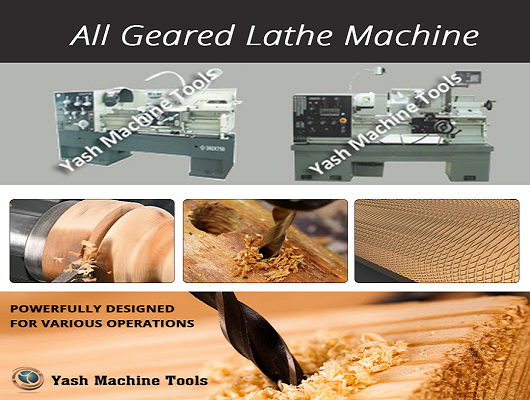Contribution of Lathe Machine to Industry
Lathe machine is a tool used to perform various operations on a workpiece. These operations can vary from drilling, cutting and grooving to deforming, sanding, knurling, shaping, etc. The operations are executed by fixing the workpiece to the bench which supports the axial rotation of the workpiece. Some of the important uses of these machine include metalworking, glass working, wood turning and metal spinning. Since its early version these machines which was horse-powered, has evolved hugely with computerized numerical control (CNC) being one of the latest technology. These machines have revolutionized the industries since its invention and are now considered one of the most important tools in most of the modern industries. Depending on the usage, lathe machines are being designed in different forms. In this article, we will see how various lathe machines are being used in industries.
- Light duty lathe machines: Light duty lathe machines are fairly small in size hence they required less space as compared to other lathe machines. Due to its small size, its maximum swing over bed is limited to 20 inches or less. Light duty lathe machines are readily in wood industries for woodturning. Other uses of such machines include slotting, turning, tapering, metal spinning and similar light applications on the smaller workpiece.
- Medium duty lathe machines: Machines of this category are made with high grade cast iron giving extra strength to its bed. This allows medium duty lathe machine to work consistently with high precision even under high pressure. As compared to light duty machine tools, these machines provide more strength to and can be used to work on bigger workpieces.
- Heavy duty lathe machines: Heavy duty lathe machines are one of the most widely used lathe machines because of its superior quality and fast rate of output. These are made from high-quality iron and steel and are designed to handle the toughest shaping jobs. It is considered for metal spinning, metal working, wood turning and metal fabricating in various industries including power plants, steel plants, oil and mining industries, shipbuilding factories, repair shops, paper textiles. Because of high-performance capacity to work on great speed, they are especially preferred for high volume production.
- Extra Heavy duty lathe machines: Depending on the type, the swing of bed for these machines varies from 630mm to 1600mm. Apart from this; extra heavy duty lathe machines provide more efficiency and better performance as compared to other lathe machines. Because of these features, it has a wide range of uses in various industries including shipbuilding, iron and steel plants, paper industry, etc.
- CNC lathe machines: Computerized Numerical Control (CNC) lathe machines use a computer to control tools and performing different operations on the workpiece. The computer is programmed with G-code. A custom computer program is fed into the computer containing instruction about the tasks to be performed. Through code, one can control various features of the machine such as positioning, velocity, rate, etc. Since it is a machine performing the task, human error in the process of performing operations is removed. The computer can perform the operations precisely and repeatedly at high speed. Because of its precision and reliable performance, CNC lathe machines are rapidly replacing older lathe machines in various industries including metal and plastic industries.
Conclusion: Since its invention, lathe has become one of the most essential machine tools. Its contribution as a multi-purpose equipment has made it a highly demanded machine in industries like Iron and steel, wood, plastic and power plants. Influence of modern technologies has caused the evolution of computerized lathe machines. These computerized machines offer fast and efficient performance and remove human error.
- How Lathe Machine Manufacturers are Powering the Nation’s Engineering Growth in Canada?
- How Chamfer Machines Are Streamlining Metalwork in the UK’s Manufacturing Sector?
- How Feed Rate Adjustments Improve Surface Finish in Vertical CNC Milling Machines?
- How Radial Drilling Machines Achieve Low Vibration and Distortion Resistance?
- From Design to Execution: How CNC Press Brakes Ensure Seamless Workflow
- How to Optimize Sheet Metal Operations Using a Hydraulic Press Brake?




